Introduction: The Growing Market for Soccer Grip Socks
The soccer grip sock segment has experienced remarkable growth in recent years, evolving from a niche product into an essential performance item demanded by teams at all competitive levels. This market expansion presents significant opportunities for manufacturers who can efficiently produce high-quality grip socks that meet the performance requirements of modern players while offering compelling price points for team purchasers and retailers. The manufacturing challenges, however, are considerable – from selecting appropriate materials that balance durability with performance to implementing production processes that ensure consistent grip patterns and sock integrity through multiple use cycles. This comprehensive guide examines the critical considerations for manufacturers entering or optimizing their position in the soccer grip sock market, from material sourcing and production equipment selection to quality control processes and customization capabilities. By understanding these essential manufacturing factors, producers can develop strategic approaches that maximize efficiency, ensure product performance, and create meaningful market differentiation in an increasingly competitive segment. Whether you’re an established sports apparel manufacturer looking to expand your product line or a specialized producer seeking to optimize your existing grip sock production, this analysis provides actionable insights for enhancing manufacturing excellence and capturing greater market share in this growing product category.
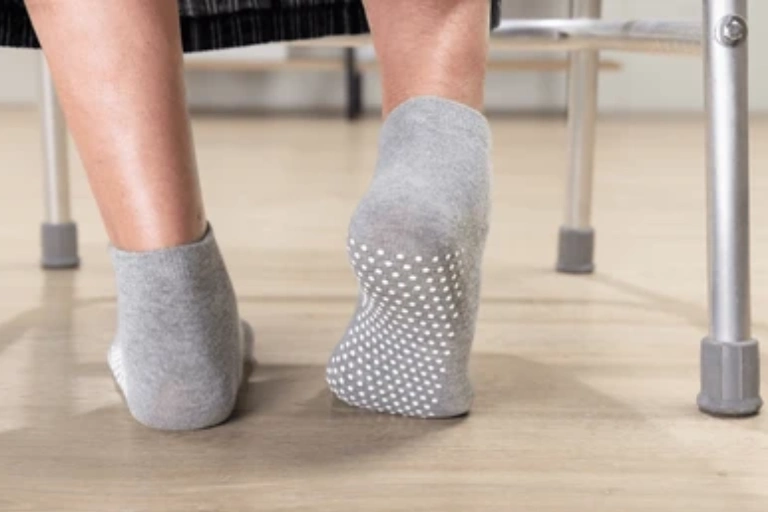
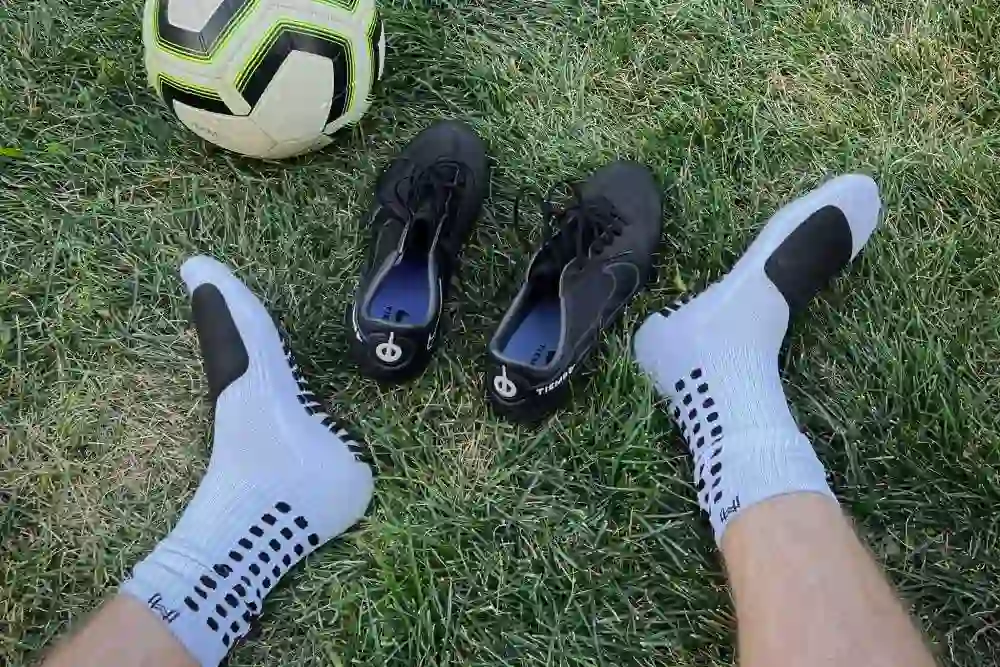
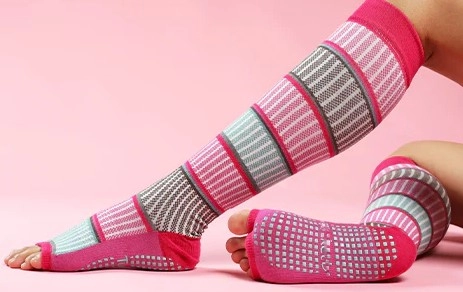
Market Analysis: Understanding the Soccer Grip Sock Segment
Before investing in production capabilities, manufacturers must thoroughly understand the current market landscape for soccer grip socks, including demand patterns, competitive positioning, and price sensitivity across different market segments. The soccer grip sock market has evolved significantly, with initial adoption primarily among elite teams and professional players now expanding to youth leagues, amateur clubs, and recreational players seeking the same performance advantages. This broadening market presents diverse opportunities but requires strategic positioning to effectively target specific segments with appropriate product features and price points.
Current Market Size and Growth Projections
The global soccer grip sock market currently represents approximately $340 million in annual revenue with projected compound annual growth of 7.8% through 2028, according to recent sporting goods industry analyses. This growth is driven by several factors, including increased awareness of performance benefits, greater adoption by youth development programs, and expansion into emerging soccer markets in Asia and North America. The market demonstrates seasonal fluctuations corresponding to team purchasing cycles, with peak demand typically occurring before fall and spring seasons in major markets. Regional variations in demand are significant, with European markets showing higher penetration rates but slower growth compared to North American and Asian markets where adoption is accelerating from a lower base. Understanding these market dynamics helps manufacturers align production capacity and inventory management strategies with anticipated demand patterns, preventing both costly overproduction and missed revenue opportunities from stockouts during peak ordering periods.
Competitive Landscape and Price Positioning
The soccer grip sock market features a range of manufacturers, from specialized producers focusing solely on performance socks to large athletic brands offering grip socks within broader lines. Premium products often come from well-known brands with professional endorsements and proprietary grip technologies.
Mid-market manufacturers typically serve customers seeking quality socks with reasonable customization options. Entry-level suppliers mainly target bulk purchases for teams and clubs, focusing on volume.
Private label manufacturing is growing rapidly. Many retailers and team dealers look for reliable partners to produce custom-branded grip socks that balance quality and cost.
Regarding minimum order quantities (MOQ), customized requirements depend on raw materials and accessories. The standard MOQ for single color and single size socks is generally 500 pairs. Some styles support stock orders with mixed colors and sizes starting at 500 pairs, offering flexibility for smaller buyers.
For detailed pricing and specific MOQ questions, we recommend contacting us directly through our website. This ensures tailored quotes that consider your customization needs, order volume, and material selections.
Understanding this landscape helps manufacturers and buyers find the right balance between quality, customization, and cost-efficiency in the competitive soccer grip sock market.
Essential Materials: Selecting the Right Components for Performance and Durability
The quality and lifespan of soccer grip socks heavily rely on choosing the right materials. Each component affects comfort, functionality, and manufacturing efficiency. Careful material selection helps balance performance needs with cost control and production compatibility.
Fabric Selection for Optimal Performance
Most high-performance soccer grip socks use blended fabrics combining polyester (50-70%), nylon (15-30%), cotton (0-20%), and elastane/spandex (3-8%). Polyester offers durability and moisture management, nylon adds strength and abrasion resistance, cotton improves comfort, and elastane ensures stretch and recovery. Fabric weight usually ranges from 160 to 220 GSM; heavier fabrics last longer but may reduce breathability. Technical yarns with antimicrobial or moisture-wicking treatments add value but increase costs. Materials must be tested for moisture-wicking speed, abrasion resistance, and stretch recovery to meet quality standards and production demands.
Grip Element Materials and Application
Grip components define soccer grip socks’ functionality. Silicone is the most common grip material for its flexibility and durability. Medical-grade silicone performs best but costs more, while PVC is cheaper but less durable and less eco-friendly. Grip application methods include screen printing (fast, low cost, thinner grip), heat transfer (consistent quality, moderate speed), and injection molding (most durable but slower and costlier). Testing grip strength, adhesion, and durability through wear and wash cycles ensures products meet performance expectations.
Production Equipment: Technology Requirements for Manufacturing Excellence
The production of high-quality soccer grip socks requires specialized equipment for both sock manufacturing and grip application. The selection of appropriate technology significantly impacts production capacity, quality consistency, and manufacturing flexibility. Manufacturers must carefully evaluate equipment options based on their production volume targets, quality requirements, and customization needs.
Sock Knitting Machinery Specifications
The core of production is the knitting machine. Modern computerized circular knitting machines with 144–200 needles offer an ideal balance of fabric density and speed for soccer socks. Single-cylinder machines create basic tube socks needing separate heel and toe finishing. More advanced double-cylinder machines produce fully shaped socks with integrated heel pockets in one step, reducing post-processing but requiring higher investment. Production rates range from 200–400 pairs per 8-hour shift for simple designs to 150–300 pairs for complex patterns. When selecting equipment, manufacturers should consider not only purchase price but also maintenance, parts availability, and pattern programming flexibility. Machines with electronic needle control allow complex designs and cushioning zones, adding product value for premium markets.
Grip Application Technology Options
Grip application involves different technologies based on the method used. Screen printing systems for silicone grips cost around $15,000–40,000, producing 600–1,200 pairs per shift but require regular maintenance for consistent results. Heat transfer systems, with investment between $50,000–100,000, offer precise grip application but slower production (500–1,000 pairs per shift) and need careful temperature and pressure control. Injection molding delivers the most durable grips but demands the highest cost ($100,000–250,000) and slower output (400–800 pairs per shift) due to curing times. Modular systems offer flexibility for multiple sock sizes and patterns, reducing changeover times. Automated quality control tools, such as visual inspection systems, are increasingly important for ensuring grip pattern consistency and meeting rising market standards.
Manufacturing Process: Optimizing Production Flow and Efficiency
Efficient production workflow is key to maximizing output and ensuring consistent quality in soccer grip sock manufacturing. This process spans from raw material preparation to final packaging, with careful planning to avoid bottlenecks and maintain smooth operations. Optimizing these steps reduces costs, shortens lead times, and improves overall efficiency.
Production Sequence and Workflow Design
Soccer grip sock manufacturing typically follows a set sequence. It starts with preparing yarns to ensure proper moisture and tension for quality knitting. Knitting is often the first bottleneck since machine capacity limits production volume. After knitting, socks undergo washing to remove oils and stabilize size, requiring careful temperature and detergent control. Drying must prevent shrinkage that could affect grip placement. Grip application is the second critical bottleneck. Socks must be aligned precisely for consistent grip patterns. Curing conditions—temperature and time—directly affect throughput and grip durability. Finally, products go through quality inspection, pairing, and packaging. Minimizing material movement between stages and using buffer stocks at key points helps avoid line stoppages from delays or maintenance.
Quality Control Integration Throughout Production
Quality control is integrated throughout rather than only at the end. Initial tests check yarn elasticity, fabric weight, and color before knitting. Post-knitting inspections verify dimensions and fabric integrity. Before grip application, socks are checked for proper positioning and cleanliness. After grip application, inspections ensure grip accuracy and adhesion. Final checks confirm pairing and overall product quality. Tracking quality data continuously helps identify trends, equipment needs, or process tweaks. Statistical process control can maintain quality consistently while reducing inspection labor by focusing on key samples.
Quality Standards: Ensuring Performance and Consistency
Maintaining strict quality standards is key for soccer grip sock manufacturers aiming to serve premium markets, professional teams, and large retailers. Quality control must cover both functional performance and visual consistency to meet high expectations and ensure customer satisfaction.
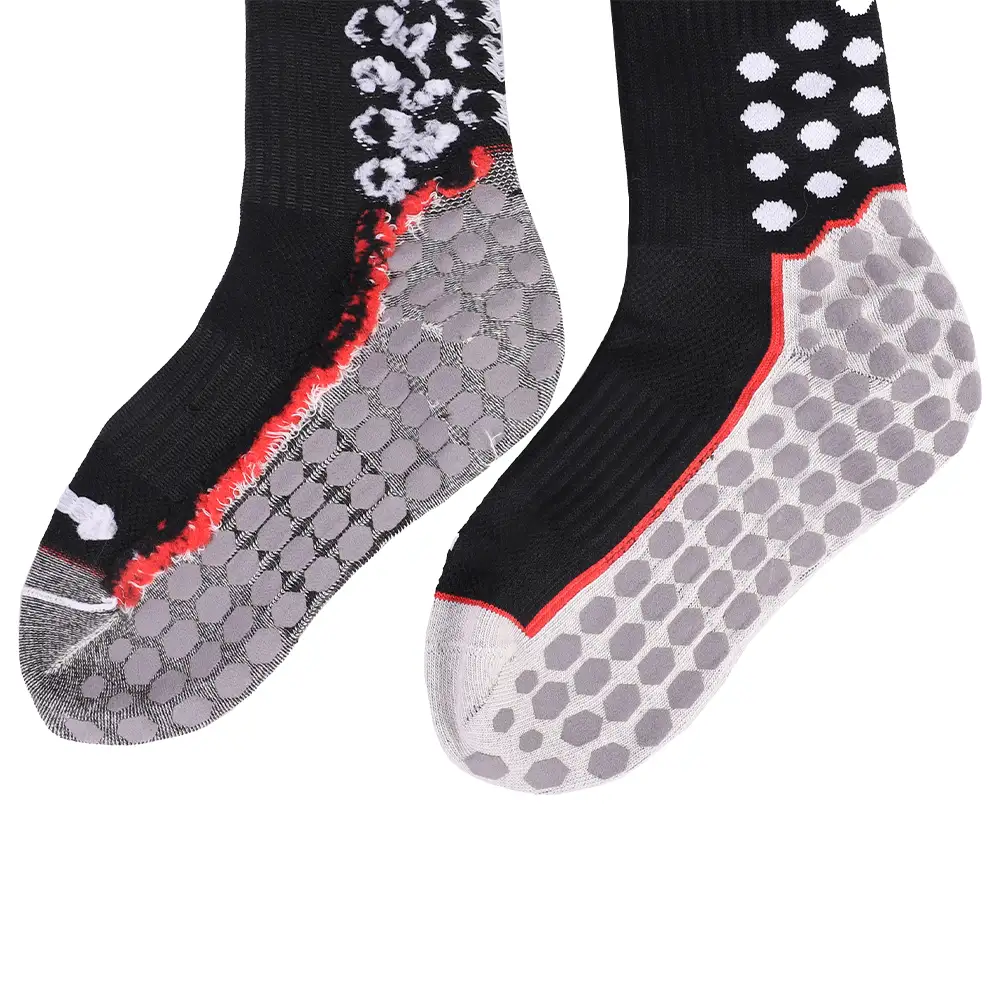
Performance Testing Protocols
Consistent performance testing guarantees socks deliver expected grip, durability, and comfort. Grip tests measure friction under dry and wet conditions, with premium products meeting minimum grip coefficients around 0.8 (dry) and 0.6 (wet). Durability tests simulate washing and use, requiring socks to retain at least 80% grip effectiveness after 30 wash cycles. Elasticity testing ensures socks stretch and recover properly, maintaining fit throughout use. Moisture management tests verify effective wicking and quick drying to keep feet comfortable during play. Regular in-process testing, not just pre-production checks, helps sustain quality and supports retailer verification.
Visual Standards and Consistency
Visual quality impacts brand reputation and market acceptance. Color consistency is controlled using standard metrics like Delta E, keeping variations minimal to ensure uniformity across batches. Grip pattern placement must be precise within 2-3mm to guarantee both function and appearance, supported by calibrated alignment tools. Surface finish quality is monitored to prevent defects such as silicone overflow or uneven application. Packaging standards ensure neat, consistent presentation aligned with retailer requirements. Clear documentation, including sample references and detailed specs, is essential for maintaining consistency across production lines or partner facilities.
Implementing these standards helps manufacturers deliver reliable, high-quality soccer grip socks that meet customer expectations and support long-term business growth.
Customization Capabilities: Meeting Team and Retailer Requirements
Customization is a key advantage in the soccer grip sock market, especially for team sales, private labels, and retail clients. Successful customization balances product flexibility with efficient production to avoid high costs and delays.
Team Branding and Personalization Options
Teams increasingly demand customized socks to reflect their identity. Basic color customization requires careful yarn inventory and machine setup, typically starting at 300-500 pairs. Logo options include knit-in, embroidered, or printed designs—each with different production needs and minimum order sizes, generally 100-300 pairs. Player personalization, like names and numbers, is a premium option requiring detailed order tracking to ensure accuracy. Pricing should consider production complexity and encourage larger orders for better efficiency.
Production Planning for Custom Orders
Handling custom orders efficiently involves modular production systems that minimize full line changes. Grouping orders by color, size, or design reduces setup times while meeting delivery schedules. Digital management tools track specifications from order to shipment, reducing errors and improving transparency. Investing in flexible equipment and possibly separate production lines for custom versus standard socks helps optimize workflows. Just-in-time inventory strategies combined with buffer stocks of common materials balance responsiveness with cost control. Clear communication with customers on design approval and timelines is essential to ensure satisfaction with custom products.
Cost Management: Optimizing Production Economics
Managing production costs effectively is key to success in soccer grip sock manufacturing. With growing competition and varying price sensitivities, balancing cost control and product quality is essential to maintain profitability and meet customer expectations.
Material Cost Optimization
Materials account for 40-60% of total production costs, making smart sourcing critical. Building strong supplier relationships and negotiating volume discounts can lower costs by 5-15%. Using pattern optimization and advanced cutting methods reduces material waste by up to 8%. Regularly testing alternative materials helps identify cost-saving options without sacrificing quality. Efficient inventory management, such as just-in-time delivery, balances material availability with minimized holding costs.
Labor and Overhead Efficiency
Improving labor productivity and managing overhead also impact cost control. Streamlining production lines and removing inefficient steps can reduce labor needs by 10-20%. Preventive maintenance keeps equipment running smoothly, maximizing machine usage and spreading overhead costs over more units. Energy-saving measures can cut utility expenses by up to 25%. Training and cross-training workers boost efficiency and reduce errors. For larger operations, automating repetitive tasks like packaging can lower labor costs and improve consistency, though investment decisions should be carefully evaluated.
By focusing on material sourcing and production efficiency, manufacturers can optimize costs while maintaining the quality and features that customers expect in soccer grip socks.
Market Differentiation: Creating Competitive Advantages
In a crowded market, manufacturers must go beyond price to build lasting competitive advantages. Differentiation strengthens market position, supports better pricing, and deepens partnerships with distributors and customers.
Technical Innovation and Performance Enhancement
Innovating products is key for premium positioning. Optimizing grip patterns based on movement analysis can improve traction for specific sports needs. Using advanced yarns with moisture-wicking, antimicrobial, or temperature-regulating features adds clear value. Graduated compression zones help muscle support and recovery, appealing to serious athletes. Better anatomical fits improve comfort and stand out from basic designs. Partnering with sports science institutions or pro teams for testing boosts credibility and ensures continuous product improvement. Proprietary grip materials can further distinguish products, though patent protection is advisable.
Service and Relationship Differentiation
Service quality and strong relationships offer unique advantages that are harder to copy. Faster customization, flexible MOQs, and shorter lead times attract teams and retailers willing to pay more. Inventory solutions like reserved stock or vendor-managed inventory strengthen distribution ties. Offering design assistance and merchandising support adds value and loyalty. Digital tools such as customer portals simplify ordering and tracking, creating switching barriers. These service-driven strategies often rely on organizational strengths rather than heavy capital, making them sustainable competitive edges.
By combining technical innovation with superior service, manufacturers can create powerful, lasting differentiation in the competitive soccer grip sock market.
Distribution Strategy: Reaching Target Market Segments
An effective distribution strategy is key for manufacturers to reach target customers efficiently with suitable products and support. The best approach depends on factors like company size, product positioning, and customer focus. Many manufacturers combine multiple channels to broaden market coverage.
Channel Selection and Management
Choosing the right channels influences sales potential and required resources. Direct team sales offer higher margins and closer customer relationships but need dedicated sales teams and longer sales cycles, fitting premium brands. Team dealer networks expand reach without direct sales efforts but require margin allowances and strong support in training, marketing, and inventory. Sporting goods retailers provide volume but demand higher margins and strict compliance with vendor rules. E-commerce, via direct or partner platforms, offers growing opportunities but needs order fulfillment capability and margin management. International distribution brings scale but adds complexity like product adaptation and payment risks. Managing channel conflicts with clear pricing and territory policies is essential as distribution grows.
Support Programs for Distribution Partners
Supporting partners beyond product supply boosts sales and loyalty. Providing education materials, sales samples, and demonstration kits helps partners present products well. Co-op marketing shares advertising costs, enhancing brand visibility. For team dealers, fitting kits reduce sizing issues, easing orders. Drop-shipping allows direct shipment to end customers, lowering inventory needs but requires reliable order systems. Though resource-intensive, these support measures build stronger partnerships and create lasting competitive advantages.
Sustainability Considerations: Meeting Evolving Market Expectations
Environmental awareness is shaping buyer preferences in the sports apparel industry, including soccer grip socks. Manufacturers must address sustainability in materials and production to meet market demands and prepare for future regulations. Embracing sustainable practices can improve brand reputation and operational efficiency.
Material Selection and Environmental Impact
Choosing eco-friendly materials reduces the environmental footprint without sacrificing product quality. Using recycled polyester—often made from post-consumer plastic bottles—lowers virgin material use and supports green branding, though it may cost slightly more than standard polyester. New biodegradable grip materials offer performance similar to silicone but come with higher costs and may require production adjustments. Water-based adhesives help reduce harmful emissions and enhance workplace safety, although they may slow production due to longer curing times. Packaging improvements, such as recyclable or recycled materials, provide simple, cost-effective sustainability gains. For credibility, certifications like Global Recycled Standard (GRS) or OEKO-TEX can verify eco-friendly claims but involve additional costs and administrative efforts.
Production Process Optimization for Sustainability
Improving manufacturing processes can reduce environmental impact and lower costs. Energy-saving upgrades like LED lighting and heat recovery can cut carbon emissions and save money, often with returns in 1–3 years. Water-saving techniques in dyeing and washing can reduce water use by up to 60%. Reducing material waste through better cutting and pattern planning decreases both environmental impact and expenses. Proper chemical management safeguards workers and limits pollution risks. Some manufacturers invest in renewable energy, which can significantly cut carbon footprints but requires higher upfront investment and longer payback times. Documenting these efforts supports marketing and helps meet growing customer and regulatory expectations.
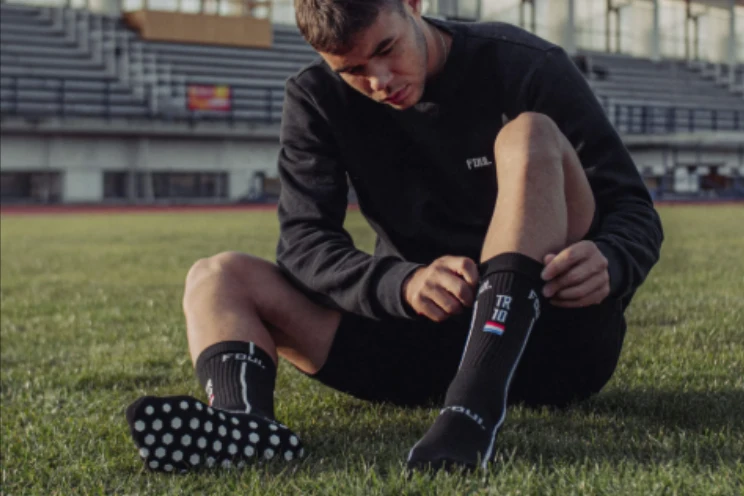
Conclusion: Strategic Positioning in the Soccer Grip Sock Market
Success in soccer grip sock manufacturing requires strategic alignment of production capabilities, product positioning, and distribution approaches with specific target market segments. Manufacturers must make deliberate choices regarding quality levels, customization capabilities, and service offerings based on their operational strengths and market opportunities rather than attempting to serve all segments equally. Those targeting premium markets must invest in advanced materials, innovative grip technologies, and comprehensive quality systems that support performance claims and justify higher price points. Manufacturers focusing on team and dealer channels should develop efficient customization capabilities and support programs that strengthen distribution partnerships beyond transactional relationships. For those pursuing volume opportunities through retail channels, production efficiency and consistent quality at competitive price points become paramount considerations.
Regardless of specific market focus, manufacturing excellence provides the foundation for sustainable success in this growing product category. Implementing rigorous quality control systems, optimizing production workflows, and continuously improving operational efficiency enable manufacturers to deliver consistent products that build market reputation and support long-term growth. As the market continues to evolve, manufacturers who combine technical product knowledge with strategic business approaches will be best positioned to capture opportunities across this specialized but expanding segment of the soccer equipment market.
FAQ: Common Questions About Soccer Grip Sock Manufacturing
What is the typical production capacity for a mid-sized manufacturer?
A mid-sized factory with 3-5 knitting machines and grip application equipment usually produces 1,500–3,000 pairs daily. Monthly capacity ranges from 30,000 to 60,000 pairs based on a 5-day workweek. Actual output depends on product complexity, maintenance, and demand fluctuations.
What are the minimum order quantities (MOQ) for custom grip socks?
MOQ varies by customization. Standard grip socks in stock colors generally start at 500 pairs per single color and size. Some products allow mixed colors and sizes at this MOQ. More complex customizations like logos or patterns may require higher quantities to cover setup costs.
How are production costs structured?
Costs typically include materials (40-50%), labor (15-25%), manufacturing overhead (15-20%), and administration (10-15%). These percentages vary by order volume, automation, labor costs, and sock features. For detailed pricing, contacting the factory directly is recommended.
What quality tests are important before production?
Key tests include grip strength in dry and wet conditions, wash durability (at least 30 cycles for premium socks), dimensional stability, colorfastness, elasticity, and wear testing. These ensure consistent performance and customer satisfaction.
What are typical lead times for custom orders?
Lead times vary: 2-3 weeks for simple color changes, 3-4 weeks for logo additions, 4-6 weeks for new grip patterns, and 6-8 weeks for full custom designs with new knitting patterns. Timelines may extend during peak seasons.
